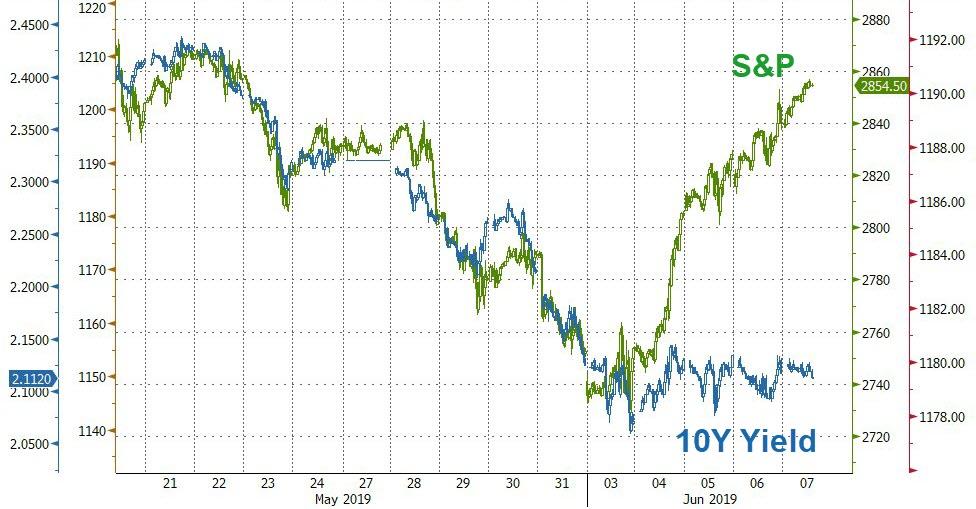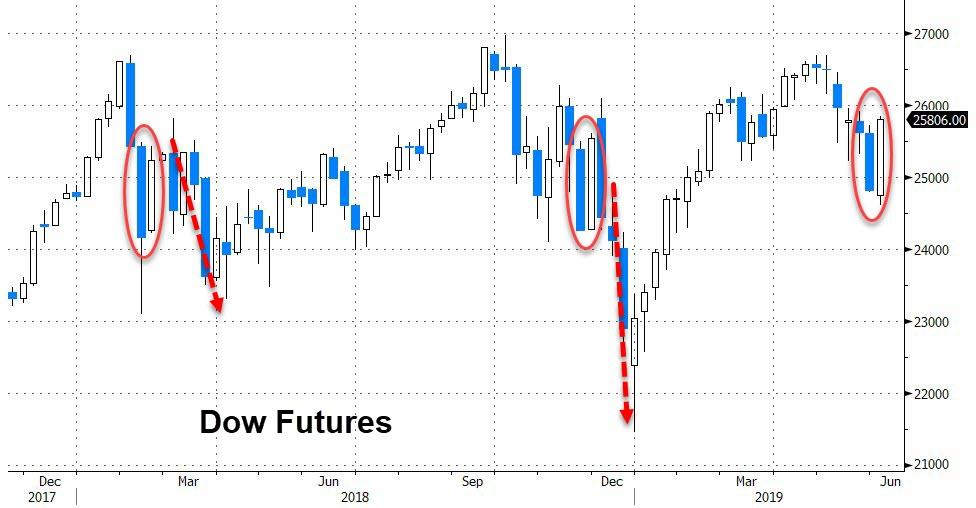With stocks set for the best start to a June since 2000 (and best week since November), one would assume that bond yields must be soaring – all that expectation of growth (fueled by expected rate-cuts and a cessation of trade wars?) – but no, bonds have completely ignored this week’s panic-buying farce.
As former fund manager and FX trader Richard Breslow notes, various asset markets have agreed to disagree on what lies ahead. Will today’s payrolls print be too hot, too cold, or – as usual – goldilocks-esque enough to solve the conundrum of bonds and stocks divorce?
Via Bloomberg,
Non-farm payrolls releases may not be the random number generator that pundits like to claim. And whether they get revised or not, until they do, they stand as the most recent marker of where we stand on the issue. To be later verified or debunked. But how markets react on the day can often be the utter wild card.
Following a definitive beat or miss from the data it’s relatively straightforward to guess what the day’s price action is likely to bring. It’s those results that fall into the statistically-insignificant-from-forecast category where it gets tricky. It’s why a lot of disciplined traders choose to trade the expectations, not the actual number. The former is playing the market, the latter can be more akin to a simple roll of the dice.
So, if the number doesn’t somehow completely change investors’ expectations, you can learn a lot more about the underlying drivers of asset prices from the run-up to a number than the aftermath. And what has been going on? A distinctly ambivalent attitude toward risk versus a realization that the world’s central bankers are much more united with each other than any reference to what their political leaders are saying would suggest.
The Fed has tilted dovish. ECB President Mario Draghi was dovish. No matter how the market chose to clear what it had to on the day. The BOJ certainly isn’t going anywhere. And today, we got an unambiguous reaffirmation from PBOC Governor Yi Gang that his institution has “tremendous” flexibility and tools to provide accommodative monetary policy if required. That was actually a sign of strength that traders should take comfort from. Is it any wonder that global equities can be bid while many an analyst continues to urge caution on global conditions in general?
Markets don’t always provide a simple, unifying theory tying every financial instrument’s movements together. Boo hoo for the correlation matrices. It’s fair to point out the inconsistencies between investor attitudes toward different markets without falling on your sword insisting that one of them has to be wrong. Respecting the price action in stocks while also having a strong desire to own bonds or yen is perfectly reasonable.
Caution, amidst temptation, about owning emerging markets may therefore be the most interesting thing going on here. The potential collateral damage from an escalating trade dispute versus lower for longer rates is being played out most vividly with these assets. How it breaks will possibly be the cleanest gauge of how people really feel about global economic conditions going forward.
EM’s fate will be much more dispositive of expectations than listening to someone try to handicap the base case scenario for how negotiations will eventually play out. And at the moment they look decidedly uncertain. Which seems entirely appropriate. Fear and greed are circling each other quietly.
The real conundrum is that no one really knows how much of the global slowdown is actually tied to trade and how much to the economic cycle.
Which makes settling on an appropriate monetary policy very tricky indeed. What’s transitory and what isn’t is entirely unknown. It’s why we talk so much about “insurance policy cuts.” Equity markets understand that is a signal of having friends in important places.
[but we have seen this pattern of hope before]
While other markets can still worry about what it all means for the real economy.
via ZeroHedge News http://bit.ly/2Wum6k9 Tyler Durden

